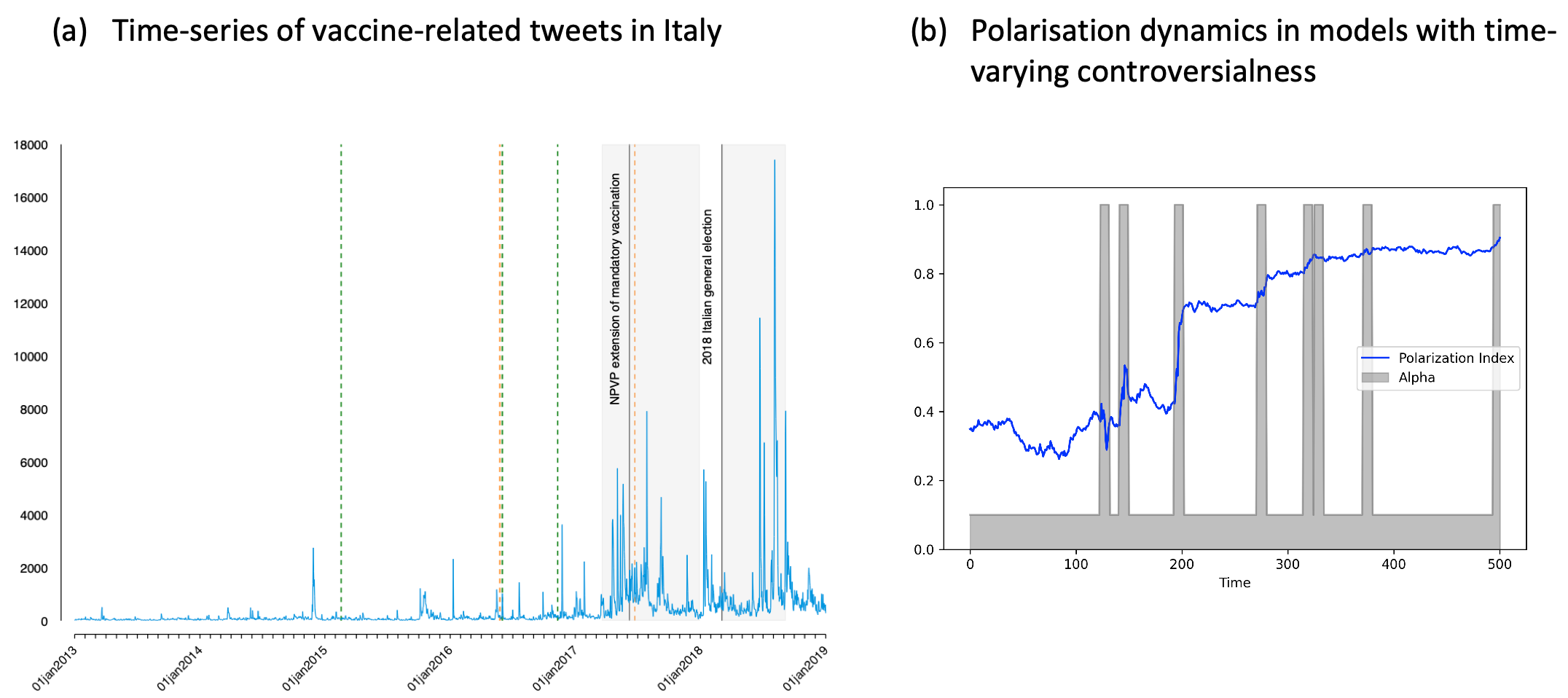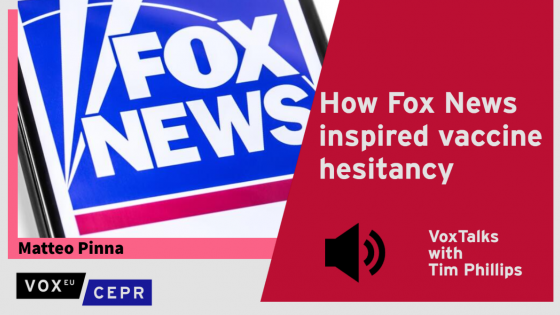The spread of misinformation through social media has become a pervasive issue, impacting not just the political and economic spheres (Enikolopov at al. 2019), but also individual welfare (Bursztyn et al. 2023) and public health. The Covid-19 pandemic magnified this challenge, as an influx of misinformation regarding the virus, its consequences, and the newly available vaccines spread rapidly across social platforms, complicating both public health responses and vaccine rollout (Agrawal et al. 2024). Another notorious example of misinformation is the debunked link between the combined measles, mumps, and rubella (MMR) vaccine and autism, a myth that has persisted despite overwhelming scientific evidence to the contrary. The dissemination of false information led to vaccine hesitancy, to the decline in vaccination coverage, and to a surge in vaccine-preventable cases. In a new paper (Giaccherini et al. 2024), we focus on Italy during the period 2013–2018 to estimate how online vaccine scepticism has ultimately impacted public health outcomes (e.g. cases, hospitalisations, and public health expenditure). In 2017, Italian lawmakers seeking to reverse dwindling vaccination rates enacted legislation enforcing stronger mandates for childhood vaccinations, including the MMR vaccine, sparking significant political controversy.
The power of social media and the role of controversial topics
Social media platforms, with their vast reach and lack of editorial oversight, have significantly hindered the public’s ability to discern factual from misleading information (Lazer et al. 2018). In addition, their structure may lead to the formation of echo chambers, where ideological segregation further fuels misinformation and polarisation, especially concerning controversial or hotly debated topics (Cinelli et al. 2021).
This also appears to be the case in the Italian debate on paediatric vaccines. In Figure 1, Panel a, we report the number of daily posts – or tweets – on the social platform 𝕏 (formerly known as Twitter) concerning vaccinations in Italy between 2013 and 2018. The data show short-lived but intense spikes in periods surrounding notable vaccine-related events.
Figure 1
Notes: Panel (a) shows the time series of the number of tweets addressing vaccinations, 2013–2019. The dashed reference lines report notable events (i.e. those covered by national media) regarding vaccination. In particular, they flag 1) verdicts (green): the reversal of the Rimini Court’s sentence by the Bologna Appeals Court, 15 February 2015; the recognition of the inconsistency of the link between the MMR vaccination and autism by the prosecutor of Trani, 1 June 2016; the dismissal by the Milan court of the appeal against a sentence establishing a causal link between the vaccine and the severe encephalopathy developed by an infant, 10 November 2016; 2) death (orange) of an infant following a mandatory vaccination, 25 May 2016, and of an infant affected by leukaemia who contracted measles from non-vaccinated siblings, 23 June 2017. The first grey shaded area marks the period of the debate, which preceded and followed the approval of Vaccine National Plan (7 June 2017, solid black line). The second grey area followed the general elections (4 March 2018) until the upcoming school starting date – a symbolic moment that created political clashes between the Italian populist parties then ruling the government due to the vaccine mandate’s enforcement check on school enrolment. Panel (b) shows the time series of the ‘polarisation index’ of the model throughout simulation times. Grey areas are periods of high controversy.
In line with such peculiar dynamics, which see bursts of debates alternate with periods of cooling off around the vaccine topic, we develop a model of opinion dynamics on online platforms. Through this lens, we show how social media fosters the emergence of echo chambers and strong polarisation, even with time-varying degrees of controversy (Figure 1, Panel b).
In aggregate, the polarisation of opinions around sensitive topics has tangible consequences, as seen in Italy, where reduced vaccination uptake has led to the resurgence of preventable diseases that prompted the legal and policy debates described above. To quantify the extent of these effects, we explore the causal relationship between exposure to anti-vaccine views on social media and public health outcomes, such as vaccination rates and vaccine-preventable hospitalisations.
Empirical analysis and main results
We measure online vaccine scepticism using data from 𝕏, specifically focusing on all Italian tweets related to vaccines. In order to gauge the stance of every tweet with respect to the vaccines (anti- or pro/neutral), we use Natural Language Processing techniques – in particular, we develop a classifier that quantifies the anti-vaccine sentiment in each message, and aggregate this measure across Italian municipalities over time. We match these trends with municipality-level data on the rates of paediatric vaccinations including, but not limited to, the MMR vaccine. To assess the impact of exposure, we use an instrumental variables strategy, drawing on insights from network interaction research (e.g. Bramoullé et al. 2009, Cagé et al. 2022). This method hinges on identifying a segment of network links that are presumably unaffected by homophily related to vaccine opinions.
We find a significant and negative impact of online vaccine scepticism on the coverage rate of the MMR vaccine, which has been the main target of misinformation. Our results indicate that a mere ten percentage point increase in anti-vaccine sentiment within a municipality leads to a 0.43 percentage point decrease in overall vaccination coverage. In other words, relocating from a municipality ranked in the 10th percentile of anti-vax scepticism to one ranked in the 90th percentile results in a decrease in overall vaccination coverage by 1.76 percentage points.
By following the ‘chain of transmission’ stemming from reduced vaccination coverage to elevated rates of vaccine-preventable hospitalisations, we estimate an additional 8.59 admissions per 100,000 inhabitants, corresponding to a 45% rise in related public health costs.
Policy implications and conclusions
Our paper highlights the urgent need for policymakers and public health organisations to engage more effectively with the public on social media, particularly in light of the recent experience with Covid-19. In further analyses, we find that trustworthy sources and informative campaigns can partially counteract the influence of anti-vaccine content online. Moreover, through simulations of counterfactual scenarios, we show that interventions such as informative online campaigns are far more effective than censorship in mitigating the effects of misinformation and in reducing polarisation. As misinformation continues to threaten public health initiatives, understanding and addressing its spread on social media platforms is imperative for safeguarding community well-being.
References
Agrawal, V, N Sood and C M Whaley (2024), “The impact of the global COVID-19 vaccination campaign on all-cause mortality”, VoxEU.org, 21 February.
Agrawal, V, N Sood and C M Whaley (2023), “The impact of the global COVID-19 vaccination campaign on all-cause mortality”, NBER Working Paper w31812.
Bursztyn, L, B R Handel, R Jimenez-Durán and C Roth (2023), “Product market traps: The case of social media”, VoxEU.org, 8 November.
Bursztyn, L, B R Handel, R Jimenez-Durán and C Roth (2023), “When product markets become collective traps: The case of social media”, NBER Working Paper w31771.
Bramoullé, Y, H Djebbari and B Fortin (2009), “Identification of peer effects through social networks”, Journal of Econometrics 150(1): 41–55.
Cagé, J, N Hervé and B Mazoyer (2022), “Social media and newsroom production decisions”, CEPR Discussion Paper No. 17358, 5 June.
Cinelli, M, G De Francisci Morales, A Galeazzi, W Quattrociocchi and M Starnini (2021), “The echo chamber effect on social media”, Proceedings of the National Academy of Sciences 118(9).
Enikolopov, R, A Makarin and M Petrova (2019), “Social media and protest participation: Evidence from Russia”, VoxEU.org, 17 December.
Enikolopov, R, A Makarin and M Petrova (2020), “Social media and protest participation: Evidence from Russia”, Econometrica 88(4): 1479–1514.
Giaccherini, M, J Kopinska and G Rovigatti (2024), “Vax Populi: The Social Costs of Online Vaccine Skepticism”, CEPR Discussion Paper 18788, 29 January.
Lazer, D M, M A Baum, Y Benkler, A J Berinsky, K M Greenhill, F Menczer, M J Metzger, B Nyhan, G Pennycook, D Rothschild, et al. (2018), “The science of fake news”, Science 359(6380): 1094–96.








